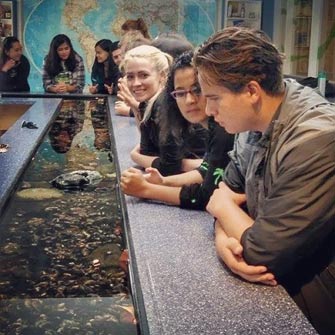How to Involve Kids in Wildlife Conservation
Published on September 04, 2014

September 4 is National Wildlife Day, a holiday that highlights our endangered species and works to educate the public about conservation. A main goal of the holiday is teaching kids about the topic, which makes this the perfect time to encourage the children in your life to get involved in conservation.
Roots & Shoots, the Jane Goodall Institute’s community and learning program encouraging youth leadership, offers a number of ways you can achieve this goal.
“Jane dedicated a lot of her life to this program to get the youth and students of the world involved in their communities to make the world a better place for animals and the environment,” says Bill Wallauer, a JGI research videographer and wildlife cameraman.
Read on for some suggestions for getting your kids interested in conservation.
Create School Programs
Reach out to your children’s teachers about creating conservation activities in school. Wallauer recommends bringing up Roots & Shoots and its educator resources to teachers. Kids working together through various activities to try to make a difference can impart a spirit of conservation.
“Adopting the philosophy is part of the solution for getting involved,” he says. “Roots & Shoots has a great structure for getting a group of students together, whether groups of students all the same age in the classroom or after-school clubs that put young kids with older mentors.”
Wallauer has seen this effort lead to results in many of the over 130 countries in which Roots & Shoots has programs.
“It’s a great way to get students not just involved in nature and conservation and wildlife protection and animal protection, but offer the idea that you can’t [undertake] conservation without local people and getting involved,” he says.
Find a Mentor
Finding a mentor, whether it’s a teacher, local conservationist or researcher, is another option. Wallauer recommends that parents find people whose work will be viewed as fun by kids and will allow them to learn more about wildlife conservation. If the person is local, kids can see firsthand how their involvement makes an impact.
“A local problem they see they can do something about — unlike issues on the news that might make them feel helpless and they see getting worse — can instill that sense of empowerment that kids can make a difference,” he says.
Volunteer in Your Community
This idea of being empowered by seeing results locally can also be achieved through local volunteering, an area where you can lead by example.
“Every town has local wildlife conservation centers, and there are all kinds of things you can do to help,” Wallauer says. “If your kids see you doing these things, getting involved, meeting professionals and meeting people passionate about local wildlife and nature — the more they are exposed to this kind of stuff — it will become part of their makeup. They wouldn’t think of not volunteering the next time there’s a need in a wildlife area.”
Visit Wildlife Areas While on Vacation
Even when you’re traveling or on a family vacation, you can involve your kids in conservation. Making plans to go to wildlife areas can be a great way to increase interest in the topic.
By exposing kids to these beautiful locations, you can start a conversation about conservation. Discuss the challenges that exist to protect these areas and what it means to protect them.
Change Your Lifestyle
Perhaps the most important thing you can do is to make changes to your everyday life and take action right at home. For example, you can create outdoor spaces, such as an ecofriendly yard, together.
“Planting native species in yards is a great thing to do with kids. In backyards, some species are highly invasive. … If we remove those and start planting native shrubs and wildflowers, some species might start to come back,” Wallauer explains. “To create that kind of atmosphere in your backyard would be a huge step in getting kids involved and interested.”
You can even just take kids outside and watch how the wild animals in your backyard or a local park behave. Learning these animals’ roles and seeing them in your own neighborhood can also help increase a child’s interest in wildlife.
Understand the Initiative’s Impact
If you’re wondering why you should get your kids involved in wildlife conservation in the first place, Wallauer says we have to realize that everyone makes an impact on the planet. It’s important to make kids aware of this and give them tools that help them feel like they can make a real difference in the world.
“When you listen to the news these days, it can be quite terrifying for kids that they’re inheriting a broken planet. … They hear about climate change and drastic storms and think, ‘What can I do about it?’ and feel they can’t do anything,” Wallauer says. “One of the reasons you should talk about this and get kids involved is that it can empower them to make reasonable and better choices than the previous generation has made. That sense of empowerment can help them feel like ‘I can make a difference and make a positive change.’”
Learn more about how you can get kids involved in wildlife conservation at Roots & Shoots.





